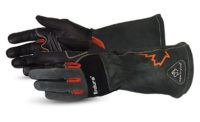We get it: choosing the right winter work gloves is snow joke. You want a pair that will not only keep you in tip-top shape while you’re hard at work, but ones that will also keep your hands toasty and warm throughout the winter season. Otherwise, you’ll be exposing your hands to dangers like cold stress, frostbite and, in extreme cases, hypothermia – and nobody wants that.
With such a wide selection of PPE available on the market these days, narrowing down the right pair of winter work gloves can be a bit challenging. To make the selection process easier for you, here are five important questions to ask when shopping for your next pair of winter work gloves.
1 What will be my work conditions?
When you’re trying to choose the best winter work gloves for the job, the best place to start is with your work conditions. Ask yourself: What will the work conditions be like while I’m on the job? Will I be working in extreme temperatures? Will it be snowing? Will I be working under these conditions for extended periods of time, or only for a short time frame?
Since cold temperatures and wind chill cause heat to leave the body faster than in other work conditions, these questions are important because they’ll help you determine which materials will help keep your hands the warmest.
2 How much insulation do I need?
When you’re trying to trap as much heat as possible inside of your work gloves, insulation is an important factor to consider. But the amount of insulation required varies depending on the factors such as gender, age, activity rate, environmental conditions (including temperature, wind speeds, and humidity), as well as the duration of exposure to cold temperatures.
To determine which gloves will provide you with the right amount of insulation, start by considering your weather conditions, as well as Clo and MET values. Basically, the colder your work environment will be, the more “Clo” (or clothing insulation) you’ll need to stay comfortable and warm while you’re working. (For reference, a 0.0 Clo rating means that you aren’t wearing any clothing, while a 1.0 rating is akin to wearing a business suit.) And, the higher the metabolic rate (or MET value) of a person, the less clothing insulation (or “Clo”) they’ll need.
When it comes to insulation, the best thing to do is to choose a glove with multiple layers – including an outer layer, a middle layer, and an inner layer that will be in direct contact with your hands. The outer layer should be tough enough to repel wind and water, while the inner layer should be soft and moisture-wicking so that it’ll keep your hands warm without making them sweaty. This way, all three layers will work together to both keep your hands warm and provide you with superior hand protection. You’ll also want to make sure that the gloves you’ve chosen are not only insulated on the front and back, but on the sides as well. Otherwise, they will let the warm air escape. For example, Thinsulate™ material traps 97-99 percent of the air that’s trying to escape.
3 Will I be working around water or in wet work conditions?
Another crucial factor to consider when selecting winter work gloves is whether you’ll be working around water or other liquids. If water seeps through your gloves, it’ll make your hands even colder. For that reason, if you’re working near water, choosing a pair of work gloves with a reliable palm coating is wise because it prevents water from being absorbed through the palm areas. Along with preventing water or other liquids from seeping through to your hands, opting for palm-coated winter work gloves also helps strengthen your grip in slippery work conditions.
And if you know that your hands will get soaked while you’re working, we’d recommend opting for fully coated gloves. That way, if any water splashes onto your hands, it won’t be able to seep through the back of your gloves.
Remember: the drier your gloves are, the warmer your hands will be.
4 Do I need a high level of dexterity?
When it comes to winter work gloves, it’s true that insulation is key. But you don’t want to choose a pair of gloves that are so thick that they inhibit your range of hand movement. For this reason, choose work gloves that are thick enough to keep your hands warm, but flexible enough for you to do your work.
And last, but certainly not least…
5 Do these gloves fit?
Though it may come as a surprise, making sure you’re wearing the right sized gloves can affect how warm your hands are in cold work conditions. If your gloves are too tight, they’ll not only be uncomfortable to wear, but they’ll also reduce your circulation – which can make you even colder. And, if your gloves are too big, you risk letting warm air escape and cold air enter.
If strong winds are a factor, make sure you choose gloves with cuffs that will fit over your jacket. This will help keep warm air trapped inside of your gloves so that your hands stay toasty.
So there you have it: the five big factors you should consider when selecting your next pair of winter work gloves. Keep in mind that, along with choosing gloves that will stand up to cold weather, it’s also important to think about which hazards are present in your workplace. Will you also need reliable cut protection? Puncture resistance? Vibration dampening? A strong grip? All of these factors will help you determine which winter work gloves are best for the task at hand.
Still feeling a little overwhelmed by all of the winter glove options out there? Reach out to a glove expert – they’d be more than happy to help you find the perfect pair.



